Angular Cheilitis Information & Facts
Learn about angular cheilitis including what it is, it's symptoms, and who it affects.
Angular Cheilitis Introduction
Angular cheilitis is referred to by many names, including:- Angular cheilitis
- Perleche
- Angular stomatitis
- Corner of mouth sores
- Cracked lip corners
- Sores on corner of lips
- Sores on mouth corners
Angular Cheilitis Pronunciation - ang-gyuh-ler kahy-lahy-tis
Angular Cheilitis Definition - Cheilitis is defined as a condition in which your lip becomes inflamed and irritated. Angular is defined as a corner or angle. So angular cheilitis' literal definition is inflammation and irritation within your mouth corners.
What is Angular Cheilitis?
While there are many names for it, they all describe the same thing and that is sensitive sores at one or both corners of your mouth. Normally these sores will start off as a minor discomfort (that sometimes mimics chapped lips), however the discomfort will generally increase and the corners of your mouth will become dry, chapped, and eventually will have red lesions. It is not uncommon for one or both corners of a person's mouth to begin to crack and split if someone has severe angular cheilitis. Learn more about severe angular cheilitis.
 Is Angular Cheilitis Contagious?
Is Angular Cheilitis Contagious?Angular cheilitis is not contagious. Many people think it is contagious because angular cheilitis looks similar to other mouth illnesses Learn what illnesses look similar to angular cheilitis. which are contagious like cold sores and fever blisters.
Can Angular Cheilitis Spread?
Since angular cheilitis only affects the corners of your mouth, it does not spread to other parts of your body. However, it can spread to the other side of your mouth fairly easily. Because of this it's important to try to not touch both corners of your mouth with the same finger, chapstick, or lipstick tube.
Angular Cheilitis Symptoms
While the symptoms of angular cheilitis could easily be described as just "cracked lip corners", it's not a very helpful description. Because of this we have created a more thorough list of symptoms below.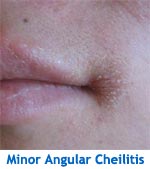 Minor Angular Cheilitis
Minor Angular CheilitisThese symptoms will generally go unnoticed by some, and to others my mimic chapped lips.
- Tightness in one or both corners of your mouth
- Small flaky skin in the corners of your mouth
- Slight discomfort when opening your mouth wide
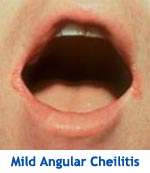 Mild Angular Cheilitis
Mild Angular CheilitisThese symptoms will generally go unnoticed by some, and to others my mimic chapped lips.
- Noticeable discomfort in one or both corners of your mouth when eating or opening your mouth wide
- Buildup of dry/flaky skin in one or both corners of your mouth
- Slight redness and/or swelling in the corner of your mouth
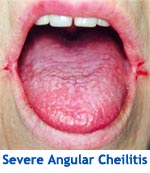 Severe Angular Cheilitis
Severe Angular CheilitisThis is generally the stage where most people realize they do not have chapped lips because the chapstick and topical ointment are not helping. Occasionally people will misdiagnose this as a cold sore or other types of mouth ailments and will attempt to treat the angular cheilitis with Abreva Learn if treating angular cheilitis with Abreva works. or other over the counter medications intended for different mouth illnesses.
- Very noticeable discomfort with eating, talking, and opening and closing your mouth
- Noticeable blisters/wounds at one or both corners of your mouth
- Split corners at the edges of your mouth which do not heal
Who Does Angular Cheilitis Affect?
Angular cheilitis can affect anyone at any age, however it is most common in the following groups of people: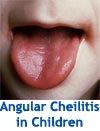 Angular Cheilitis in Children
Angular Cheilitis in ChildrenIt's not uncommon for young children to occasionally get angular cheilitis. However, they usually have a faster recovery time and rebound faster than others. While it can happen with any child, it's most common in children who drool while eating/sleeping, are sick, or are under a lot of stress. View more pictures of angular cheilitis on children.
 Angular Cheilitis During Pregnancy
Angular Cheilitis During PregnancyIt's also not too uncommon for women to get angular cheilitis during pregnancy. Because the bacteria/fungus that causes angular cheilitis is already in our saliva, angular cheilitis can occur whenever the body is under stress or whenever the body's immune system is weakened. Since pregnancy causes rapid changes in a person's body angular cheilitis can occur at any time during pregnancy, however it is most common during morning sickness.
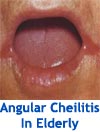
Angular cheilitis is the most common in elderly people. This is because elderly individuals generally have weaker immune systems, have excess saliva (from dentures, drooling from sleeping, loss of teeth, etc.), and suffer from more angular cheilitis vitamin deficiencies Find out if vitamin deficiencies can cause angular cheilitis. than younger adults and children.
Others
Angular cheilitis can affect anyone regardless of age or health. Since most cases are caused by the bacteria/fungus within and mouth and lips all it takes is a weakened immune system (either from illness or stress) and/or any type of mouth trauma.
Angular Cheilitis Scars
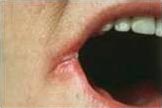 While rare, it is possible to get semi-permanent scars in the corners of your mouth from angular cheilitis. Generally the scars are not visible unless your mouth is open and look like darker patches of skin in the corners of your mouth. Since the human mouth heals very quickly, getting scars is not common unless you are suffering from
severe angular cheilitis Learn more about severe angular cheilitis.
or if you suffer from it frequently.
While rare, it is possible to get semi-permanent scars in the corners of your mouth from angular cheilitis. Generally the scars are not visible unless your mouth is open and look like darker patches of skin in the corners of your mouth. Since the human mouth heals very quickly, getting scars is not common unless you are suffering from
severe angular cheilitis Learn more about severe angular cheilitis.
or if you suffer from it frequently.

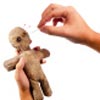 Learn what causes angular cheilitis and what can make it occur more frequently.
Learn what causes angular cheilitis and what can make it occur more frequently.